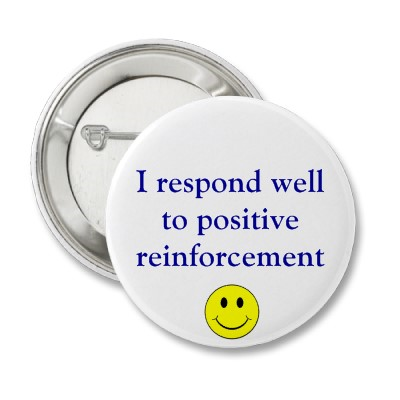Small things add up. When it comes to producing results from positive reinforcement a small difference influences results dramatically. Most effective leaders, managers, and supervisors do not necessarily reinforce more often than ineffective ones. It’s the detail of what they focus on that makes them better. Discipline to this detail compounds over time. It delivers steady pressure on the fly wheel which Jim Collins notes distinguishes the Good to Great companies. Eventually it provides the impetus to breakthrough. There is no miracle moment. Breakthrough only comes through daily discipline of doing the right things right.
In the book Switch, Dan & Chip Heath extol the value of “Select small wins that have two traits: 1) They’re meaningful 2) They’re ‘within immediate reach.’ And if you can achieve both traits, choose the latter.”
How do the best leaders and managers deliver positive reinforcement to make greater impact? In Bringing Out The Best In People, Aubrey Daniels notes a study by Dr. Judi Komaki (1986) that found most effective leaders, managers, and supervisors do not necessarily reinforce more often than the ineffective ones. What they do is reinforce while people are performing.
To be able to do this effective managers and leaders must to what? Spend more time in the work area.
Where do you think the ineffective supervisors spend their time? You guessed it. In their offices.
Of course the next question is for self examination. Where are you and your managers spending most of your time?
The answer should provide you with why you are or aren’t effective giving positive reinforcement.
A reminder, here, that positive reinforcement is the only method of getting consistent continuous improvement in your work place.
What do you need to do more of? What needs to change in your work environment so that you can your managers can spend more time reinforcing positive performance?
The only behavior a supervisor can reinforce in his or her office would be whatever the person is doing in the supervisor's office. How much of your time and your managers time is out in the workplace versus being spent in an office or a meeting room?
When reinforcement is immediate, you know what you are reinforcing because it is happening before your eyes. The performer receiving the reinforcement is almost certain to know which behavior is being reinforced.
The longer reinforcement is delayed, the less sure you are of which behavior is actually being reinforced.
Don’t believe this small detail is important? Let me provide you with two quotes from winning professionals that obviously understood this principle very well:
“Even small successes can be extremely powerful in helping people believe in themselves. When you set small, visible goals, and people achieve them, they start to get it into their heads that they can succeed.”
Bill Parcells, two time Super Bowl winning coach
“When you improve a little each day, eventually big things occur… Don’t look for the quick, big improvement. Seek the small improvement on day at a time. That’s the only way it happens – and when it happens, it lasts.
- John Wooden, UCLA coach.
Finally one from an industry leader: "It's the little things that make the big things possible. Only close attention to the fine details of any operation makes the operation first class." -- J. Willard Marriot
We must reinforce immediately. We must be in the workplace among our people to do this. How often do we need to reinforce? It might surprise the frequency you need to be effective. It may even explain why you’ve not seen the results you expect even if you feel you are good at positive reinforcement. That’s next blog.






.jpeg?width=150&height=135&name=Hand%20with%20marker%20writing%20the%20question%20Whats%20Next_%20(1).jpeg)

